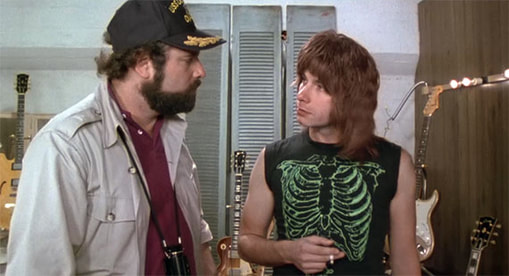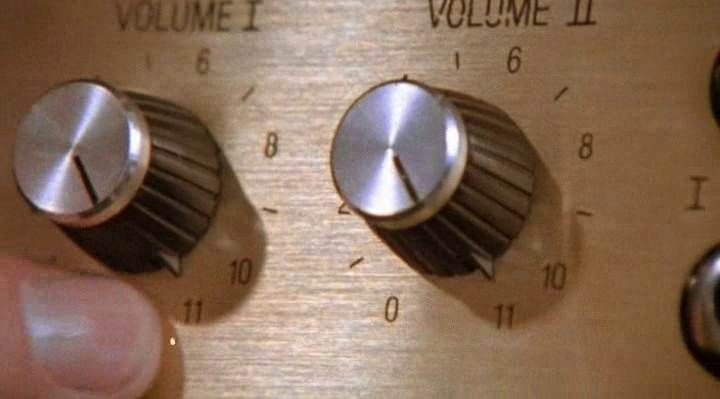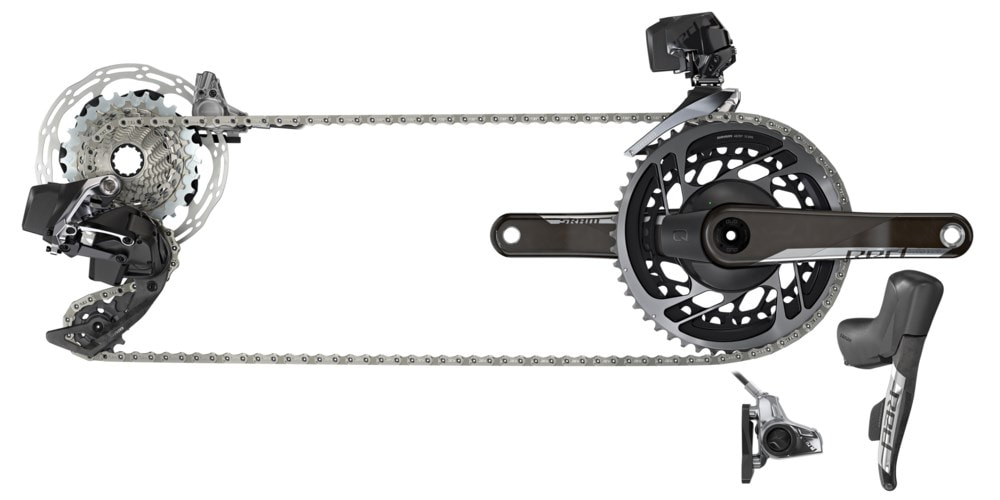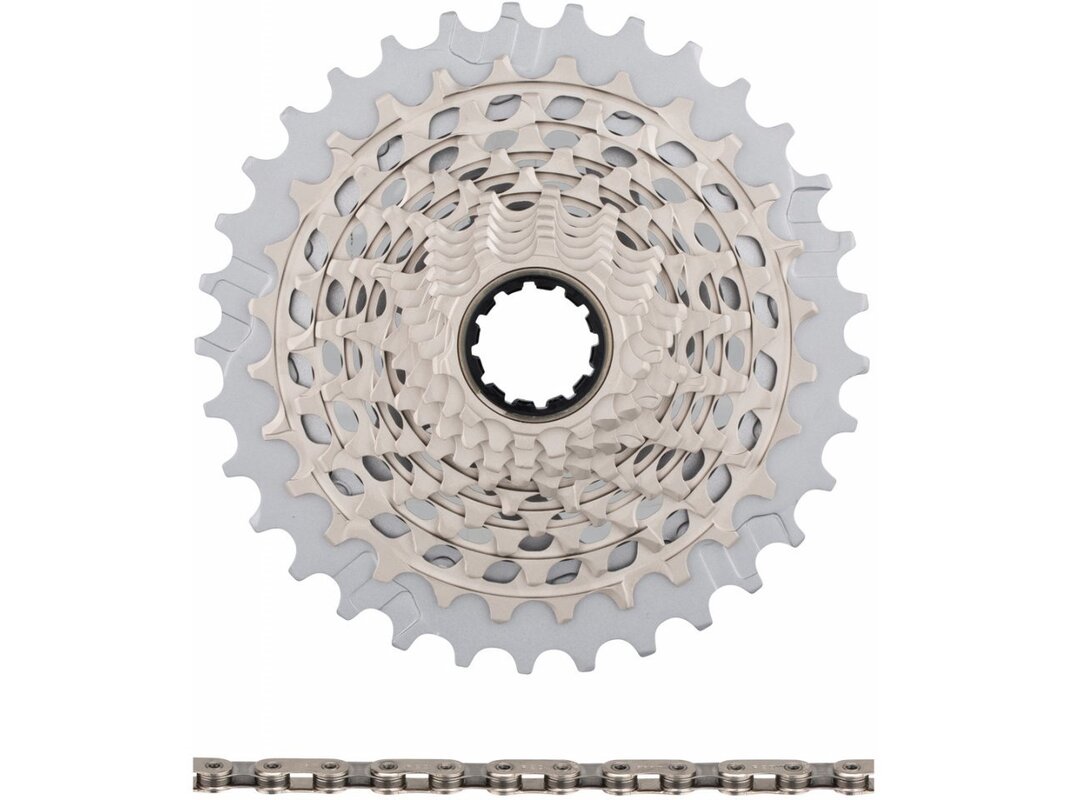 Spinal Tap's Nigel Tufnel succinctly summarized the glamor of going to "11" with his Custom guitar amplifiers. What will live in infamy was this conversation where Rob Reiner his pseudo-Biographer in the Mockumentary asks him why the amplifier maker doesn't just make "10" the top volume increment, and make "10" the loudest. (e.g. the increments of volume from 0 to 10 would effectively have the same effect, achieve the same output, albeit with a tighter scale). "But this one goes to eleven"... This famous rock-star retort could be applied to bicycles if the wilderness of patents weren't so difficult to navigate. It could easily be said that the "Ten-Speed" bike was the first increment in the arms race that stretched everyone's imaginations toward an ideal range which everyone could get on board with. Two gears up front, and five (non-indexed) gears in the rear. Both shifted with two levers on the down-tube, a simple fresh innovation that ushered in the first massive boom in bicycling since the 3 speed. More gears, meant more speed right?, after all we soon came to fondly endear them in our lexicon, as "10-Speeds", and not as '10-Gears' It seems that the "10-Speed" term of endearment, would stick around for some time, and nothing really so monumental came when 11 speeds came to market. Our elders will recall freewheels from Rigida, with removable cogs, and gear ranges that could be adjusted, You could select your ratios, and place each of the gear on a spline and then screw that onto your threaded hub. Another innovation came with "Maxi-Cranks" putting the free-wheel mech in the Bottom-Bracket, so the pedals wouldn't move whilst the wheel spun. All innovations landed us in the same place... "Ten-Speeds", became the gold standard for more than a few decades. Indexing may have made shifting more slick, but for some it meant constant adjustments & compatibility issues amidst index standards. It's really laughable when you consider that a Campy lever couldn't index a Shimano Freewheel, but it could shift a Sachs, at least most of them... The challenge is much like Big Data, who have all decided that they won't share anything, so each tries to re-invent the same gadget using borrowed parts, and stolen ideas. SRAM products used to really suck, (that is they were plagued with corollary issues provoked by the Titans at Shimano who seemed to throw a spanner in their works at every turn. Seems that they owned a lot of tech, and sharing was not their strong suit. For SRAM, nor was the idea of licensing. Since the first smooth "Grip-shift"). When SRAM, a tiny enterprise in Old Town, Chicago came to market with 'grip-shift', the gears were barely 21. A grippy plastic Cylinder with some teflon grease would pull the cable of your Shimano Derailleur up and down the cogs in snappy little clicks. Grip-shift showed Shimano, that there was a new idea out there which could work with their stuff. The crucial element was the innovation. Had Shimano bought them right then, instead of making their own twisty, the world would be a far different place. The truth is that SRAM never did like the front derailleur, and they always struggled with making their front mech shift well. Before Red, SRAM hired an outside firm to help them tip-toe through a mine-field of patents to finally land upon a functional version which worked almost as well as Shimano, and Campy. When eTap arrived Shimano felt the shock-wave of the wireless bomb-blast, which would rob them of millions in high-end revenues for a few production years. eTap wireless shifting works pretty well, and it "...goes to eleven". The trouble with going to eleven, brings one simple question: Would you rather have Eleven gears which shift pretty well, (perhaps a click or clunk here or there) Or would you rather "make Ten the loudest", and have every gear index so smoothly that you could do it under full load on the uphill, and scarcely notice the transitions? "But this one goes to Eleven"... I'm not saying that innovation is not the engine that makes Cycling fun, but it is not necessarily the engine that makes it go forward. We could have all ridden internals from Rohloff, or NuVinci, and never known that 12 was coming. In fact Shimano's internals are amazing, range notwithstanding, and internals are clean and nearly flawless. Could we not have fit them all in a hub?... We would have been fine. Now, by good ol' American ingenuity we have arrived at the narrow solution for that pesky problem of making the front derailleur work... One company's answer was to just remove it. It's almost difficult to imagine the simple ingenuity of this idea, and yet it seems that it was due. Not so long ago we had three gears up front, and 8-9 in the rear. More gears is a bit like more speakers in 'surround-sound'. Dolby doing the industry a solid by incrementing the need for more speakers each year, until the consumer got so tired of the complexity that they gave birth to the 'sound-bar'. Generally this "arms-race" for gearing was the "innovation" that was driving sales. More gears, more speakers, and we all tabled for a moment our apprehension that all of it was merely making us miserable. Shifting became more complex, chains narrowed, and people drank the Kool-aid sunning themselves in a splash pool in the yard revering their fickle bike in the background with a chewed up chain-stay, which they seldom rode. When 'Eleven" came, SRAM created the first real important innovation which was less that of tech, and more that of Marketing Lexicon, and necessity. "One-by" or '1X', became the new "Ten-Speed" (10-Speed). Then came '12'... Fuck!! Really? Do we need another cog?, a wider spread?, deeper dish?, a wimpier chain? Alas I won't lament about the pros and cons of 11 vs 12, 1X vs 2x... but I do have to say this one thing that has been nagging at me. If I embraced eTap, I bought it, I own it, and it's paid for -- It is wireless & 11 speed, and I wanted to go to 12, why do I need new shifters? The shifting is virtual right?, it is a virtual digital index sending a wireless signal to a derailleur to increment, and as such, If I pay SRAM for a new cog-set, chain, and derailleur, then why do I need to bleed my brakes, buy new shifters, re-wrap my bars, and change-out the whole mess? The upside to 'Going to Eleven", When we forget all about our old kick-ass stereos, and our 'ten-speeds", skip right through Surround-Sound, we are left with an empty feeling and a single sound-bar, (sort of Like "One By") It's simple right? Now that 12 is the new normal, and '1X' the new "10-Speed" can we get some relief? Well... if you want that single gadget to work properly, you'll have to pay the man. I think we all know why, and in response to a reasonable request for a totally do-able thing, Nigel from "Spinal Tap" summed it up succinctly, "But this one goes to eleven". If you are not the least bit upset..., then perhaps you are not paying attention.
2 Comments
 Everyone likes to get mail. A tangible letter written to you, for you, with content that connects you to another person, place, or thing. Sometimes the mail brings one, but most of the time, you get crap. Once or twice a year, you can count upon a card for a holiday, or special day, but you get what you give, and most people don't even know what a "stamp" is, let alone how to affix one to an envelope or card. You can pay people to notice you, in the form of a Magazine subscription, or you can buy some crap from one e-tailer, and get a relentless barrage of recycling from thirty more. Like rabbits, the catalogs keep coming, and for shit so non-corollary, that you'd think that you unwittingly changed gender, religious affiliation, and tax brackets the moment you ordered a chaise lounge. I think I need a larger post box just for the shit which in no way reflects my consumption. We can be amused or appalled by what comes in the mail, some junk the antecedent of the former occupant, and some just plain mis-aligned with your character. When a personal card comes, and it's an invite from AARP, you can recycle it without further review. When a handmade card comes from a relative, it is gold. I used to think that magazines were cool, and I felt a connection with the content, and the tactile nature of reading articles in successive 2 minute sittings, over a week or so. I used to get satisfaction from a clever anecdote or bio from a far flung universe. Mostly, Magazines represented what Nat Geo, and Life came to create, this was a departure from the day to day, and an escape in a tiny capsule; bound into a tidy paper package, the magazine as a momentary respite in a far-flung foreign land. When I became capable of paying for a subscription, I'd get kid-specific mags which represented a synopsis of some comfortable view-point of the world that I could relate to. Later in life, we evolve into a magazine which further stretches from our dominion to another, and some we subscribe to for uncomfortable or "seat-of-the-pants" perspectives. Some we get just to peruse the pictures. Now I get some outdoor & bike mags to stay up with innovations, as seen through the lens of a few selfish, and formerly scrupulous editors. When a new mag comes, (less frequent now due to reduced subscribers, and publishings), I'll smile and flip through it, eager for some synopsis of cool gadgetry, or innovative product. I'm sure some Mags still generate solid content in fits and spurts, but I can tell you which ones do not. One is Esquire, and the other is Bicycling. Bicycling Magazine (a Hearst holding) has reduced both it's frequency, and its' content to crumbs. Perhaps this is a sign of reduced staff and the creative collaboration of a group of people challenging each other in an office, vs. a team of disparate scribblers penning ideas and submissions on a contract basis. Of course in Bicycling, You can still count on a 20 year old photo of some cherubic shrew selling pheromones to lonely men; (I'm quite sure she doesn't look like that any longer, or even exist). You can also count on an Ad for some sort of titanium accessory which hits a niche so tight, that it can only be wielded from its' crevasse by the future king of some bizarre retro bike cult, where people still wear mesh helmet covers, and use toe-clips with white leather straps. This Month, Bicycling featured a bike on the cover which I own, and you'd think that that would make me smile, and say, "Wow! cool my purchase has been validated by someone else in popular culture" -- But that didn't happen. The cover featured the bike as part of some drivel about the best bike/s ever. Ever! So I flipped through the first thirty pages of ads, and advertorials to read something about Gerard Vroomen and the how & why the OPEN Cycles U.P.P.E.R. is good. I must say that while I appreciated the advertorial, as I'm certain Andy and Gerard did the mag's cover page... The writing and sloppy meandering justifications for what was supposed to be 10 bikes that change the world, read like foreign language phrase cards, in a jumbled pile on the floor... that article never resolved anything for me. I read through my new mag on a sunny afternoon on my chaise, with a cold Pellegrino, and found nothing there again. It's getting to the point that I can hear the telephone conversation between the editor, and the brand. "Hey man can you do us a solid this month?, we have a shit ton of bikes to sell and we are maxing out our ad budget, and we need you to take everyone through he history of the Specialized Tarmac, from napkin sketch to race-wins, but, Although it's 'historical'..." -- "Can you please feature only images of our current Product line"?... "Cool thanks man!!", "We will send you some swag with a check next week". It's well known that OPEN Cycle's reputation has been hard-earned from the underground with clean simplicity, and solid design. There is no bullshit in the company, because the company is a few slick dudes. It should not be diminished, what a great bike the U.P. is, but when a big mag features a bike as the best EVER, they have a responsibility to give their article context, and more than one editors praise. When a Hearst Magazine features a "History" of the development of the dominant Specialized Tarmac, shouldn't they also show at least a few historical images of that development, or even an image of the first version compared with the current? Nah!! they don't have to do that. Imagine a rag like Consumer Reports running editorials about V.W. instead of their typical passionate praise for Honda. Oh wait!! they already bias their crap., my bad. So Bicycling did just that... They wrote a jumble of praise for some bikes without much context, and NO historical images. They basically sold through Specialized Tarmac Inventory, and Pushed some more obscure brand agendas to any lacky who'd happened to pick up the mag waiting for a flight at an airport kiosk. In-spite of such insouciance, I will give a big high-five to the "Bikes Are Heritage" article by Morten Okbo. This colorful expo of Italian bicycle titan Ernesto Colnago, and his Muse Fausto Coppi, may be the first piece of solid, passionate, and engaging writing from Bicycling Magazine in years. It is a brief Bio into an iconic brand, It is a nod to fascinating historical figures, as well as a near religious reverence for the force of one passionate person in steadying if not shaping an industry. This article is where you could stop, because this is the only story aligned with the Cover Claim, "The 10 Greatest Bikes Ever" If Bicycling is going to get it's "learn" on, and the articles are to be "historical" in nature, as noted by the word "Ever" they should be sufficiently more than an opinion vacuum, lacking for anything contextual, historical, or non-biased -- Generally indefensible Op-Ed's header themselves as "Opinion" or with the following words: [Paid Advertisement]. I love my OPEN, and my Specialized, and my Trek..., but If I ever delivered an advertorial styled self-serving scoop of drivel lavishing one bike with superlatives, such as the Specialized Tarmac, let's hope I'd give some historical context, and a few other opinions. If I ever deliver a "History of", then let us hope I'd include a few readily available pictures of that historical process. The Tarmac article was Pure Advertorial. Last I checked, "Ever" includes a long backlog of history, if even a hint of the future, In this Issue, Number 4, we have Ten readily available current stock bikes, that you can rush right out and buy. Could we not have included somebody's Raleigh Three-speed, Flying Pigeon, or Opa? Thank you Bicycling Mag for further clouding the historical water with bits and pieces of journalism that give new initiates absolutely nothing solid to ride on. Flush! Oh, and that reminds me..., Now that OPEN cycles in the best "Ever", and have a new horse in their stable which is wider, fatter and a lower slung "one-by" than the U.P.P.E.R, -- Should Bicycling retract their story pending a test-ride? Is the new WI.DE. Bike a more overt push toward resuscitating the pure nostalgia of the rigid hard-tail Mountain Bike, c. 1997? I won't dialog on your blog, as invited by the cover... The bait has been nudged, but it fell off the hook. Sadly preceding an article with "A Preposterous, Barely Defensible, Overly Passionate (And Super Useful) Ranking" does not excuse the title using the "Ever" superlative. If, one were to list the "Greatest Bikes Ever", then they'd have to begin sometime back in history. For many mortals that would include a Klein, a PK Ripper, or a Mercxx. For others that may include a Schwinn Pixie, Collegiate Sport, or an Orange Crate. For those who would like to enter the banter, the link is: Bicycling.com/GOAT . "EVER" is a long time, decidedly not limited to ready stock from a few makes. "Ever" = "Fake News". In a sporting nod to the prowess of my OPEN U.P.P.E.R. (contender for greatest bike 'ever', and also the cover photo) It is a good bike, among many. I would bring it to any un-charted territory, prepared to suffer a bit if that ride turns out to be smooth pavement or boggy mud. Is it a category killer? Well, um, it's not really in a category, so much as it straddles a few. I rode a tempestuous century on my OPEN though the countryside this week. Through the deluge of all day downpours, over gravel, mud, pavement, grass, fields, and general crap... My OPEN U.P.P.E.R. did all of this with aplomb. I'm happy that I was solo on the flats, so nobody had to hear my cursing. The OPEN is awesome, and one of very few swiss-army knives of the road-bike world, which seem to "get it right", much the same as the new Salsa, Giant or Specialized may deserve... (or most historical Cyclocross bikes) -- But on the flat smooth road it is not "all that", and it is NOT as fast as my other road machines. Not even close. Is it good? Yep. Is it great? Yep. is it an all in wunderkind? For the editor at Bicycling Mag, it seems to be. Can you get one bike?, an U.P. and sit on your hands for the next few years until another Meisterstück evolves? You could've until a few weeks back when the OPEN WI.DE. arrived, so now you split the baby. Of course neither are road bikes, per se. No, sadly; If you are riding pavement exclusively, and need to go hella-fast, you'll need something else. If you can only get one bike... then the U.P. platform is groovy. Simply put, the U.P. Platform was built for the owners for what they wanted in a versatile road bike; which is a crazy cool way to run a company if you are lucky enough to have a bike company to run. As Gerard from OPEN recently said about his own bike, "I'm slow, right? But...Even though I'm slow, I want to go slow faster" |
Age and Treachery will overcome youth and skill. Archives
January 2024
Categories |





 RSS Feed
RSS Feed